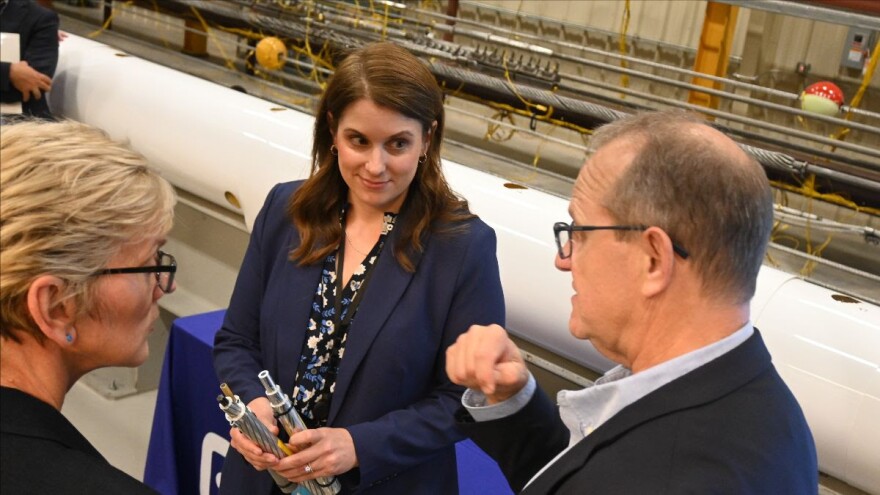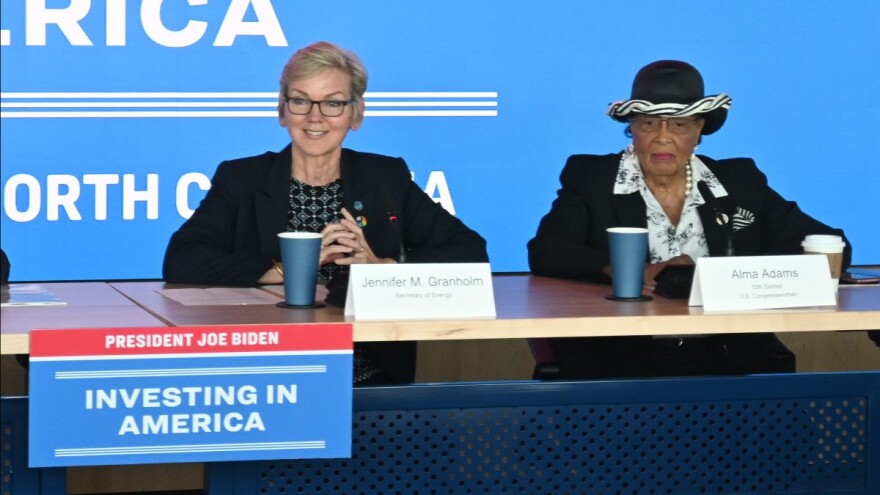This story appeared first in reporter David Boraks' weekly email newsletter. Sign up here to get the latest news straight to your inbox first.
U.S. Energy Secretary Jennifer Granholm chose Charlotte as the starting point this week for a four-state road trip through the South to promote the Biden administration's investments in clean energy. I tagged along for the day with a camera and microphone as she visited Electric Power Research Institute (EPRI) in northeast Charlotte, Lowe's Corp. Tech Hub in South End, a community town hall at Johnson C. Smith University, and Albemarle Corp.'s lithium processing and future mine site in Kings Mountain.
Granholm and her entourage are modeling climate-friendly behavior. On the trip from North Carolina to South Carolina, Georgia and Tennessee, Granholm is in a Cadillac Lyriq electric SUV. ("Really nice," she told the crowd at JCSU.) Other U.S. Energy Department officials and reporters on the trip are also using EVs, provided by the department: a Ford F-150 Lightning and a Chevy Bolt.
The former Michigan governor is talking up federal incentives to help people buy electric vehicles, install solar panels and batteries, and switch to non-fossil-fuel appliances — and save on their energy bills. She's also visiting businesses that are helping to modernize the power grid and contributing to our shift to electric vehicles — some funded by federal grants. And she's promoting the Biden administration's climate policy as a jobs program.
"We wanted to come to the South because employers are coming to the South," Granholm said during a town hall at JCSU Monday afternoon. "I wanted people to get excited about what the employers are doing to help bring the word because it is going to mean a huge number of jobs. We want you all to tell your family members that these jobs are going to be available."
"The president (is) really interested in ensuring that every pocket of America benefits from this agenda," Granholm added.
At the various stops, we reporters had a chance to ask Granholm about all kinds of climate- and energy-related topics. Here are a few responses that stood out to me.
The energy grid is not ready for climate change: North Carolinians saw this last December when single-digit temperatures led to power plant breakdowns and forced Duke Energy to cut power to thousands of customers. Granholm called on Congress to appropriate more funding to modernize the grid. At EPRI Monday morning, she told reporters:
"We've got to take seriously the hardening of the grid. And when we say hardening of the grid, that means in areas, for example, that are prone to hurricanes, to wildfires, undergrounding those transmission lines. That's expensive. And so if the technology is there, the funding needs to be there. We have something called the GRIP program (Grid Resilience and Innovation Partnerships) under the bipartisan infrastructure law that's got $10.2 billion for resiliency. States have made applications into it to identify their most vulnerable lines and to address them. … Because these extreme weather events are happening with more and more frequency in more and more places. We really need as a nation to take care of this, the largest machine that we have, which is the U.S. electric grid. It was built in the 1950s, in many places on wooden poles. I mean, it is not equipped, it's not fit for purpose today. And that's why the funding necessary to be able to protect our communities is hopefully something Congress will revisit."
Granholm said states spent $160 billion last year to clean up after extreme weather. She said she'd rather spend money upfront, to avoid those costs.
On grid security: Last December, someone shot up two electrical substations in Moore County, North Carolina, knocking out power to 45,000 customers, some for up to five days. As I've reported, similar attacks have happened across the country, prompting security experts to call the grid "America's Achilles' heel." Granholm was asked about the concerns.
"Beefing up the security measures around the substations is very, very important. Glad to see North Carolina address this issue by upping the penalties for attacking substations. (Gov. Cooper signed the legislation June 19.) But honestly, cameras are really important to that. A lot of substations in remote areas don't even have cameras. So some of the infrastructure that's necessary for that is kind of basic. And we have been talking with utilities. We have an electricity sector coordinating council that the Department of Energy works with utilities on. It is very top of mind for all of them. And I know the utilities themselves are seeking to up their game in terms of beefing up their infrastructure," Granholm said.
Granholm was asked about possible federal regulations. "Well, let's just say this: We're in discussions with utilities," she replied.

On federal incentives for homeowners and renters: At JCSU, Granholm told the audience of about 60 people that the Inflation Reduction Act (IIRA) and Bipartisan Infrastructure Law (BIL) have something for everyone. Rebates are available, or will be available this fall, on home solar panels and batteries, and home appliances such as electric heat pumps.
"People who are installing induction stoves, heat pumps, insulation (are) cutting their bills in half and more every month. I mean, it is amazing if you can afford to get these technologies in your house, right? So the president says, ‘Why not?’ Why don't we adopt a law that provides rebates at the point of sale for people to be able to buy these kinds of technologies and make it easy? And why don't we incentivize people to be able to install renewable energy generation. You can now get 30% off the installation of solar panels for your home."
In North Carolina, by contrast, regulators have approved Duke Energy's request to slash incentives for rooftop solar by reducing rates paid to solar owners for excess electricity sent to the grid.
[More information is available at the energy department website for homeowners and renters. And Rewiring America has an online calculator to help you figure out what you're entitled to.]
Addressing environmental justice and structural inequality for grants: The secretary acknowledged that when it comes to federal grants, some communities have more difficulties than others in applying and winning funding.
"Historically, there have been disparities that have been built into the system — structural inequality. … At the Department of Energy … we have a whole team that is focused on environmental justice. And we now have built in what we hope is going to be structural equity into how grants are made. So for example, we put out a competitive funding opportunity for, say, wind. And (with) the projects that come back in, 20% of the evaluation is: Does this project have a community benefits agreement? And is the community at the table? Is there a workforce plan? Have they helped to craft the strategy at it, forcing developers to have partnerships with the community and not doing it to the community? And they're graded on that, and if they don't pass the grade, they don't get the grant. So that is critical," she said.
"And the second thing is through the tax credits that are part of this," Granholm said. "If you're a solar developer, you get a 30% tax credit for developing solar. But get this: If you're a solar developer and you decide that you want to go to a disadvantaged community and put solar on rooftops for multifamily homes, you get an additional 20%. So now you have 30% plus another 20% — you got a 50% tax credit. On top of that, if you use domestic content, solar panels made in the United States, you get another 10%. So now it's a 60% tax credit, urging those investments to go to disadvantaged communities. That is part of the structural equity that has been built into these laws, hopefully righting the past wrongs by embedding it into policy. So it's pretty exciting."
Bringing clean energy jobs to the U.S.: At JCSU, Granholm cited research by the World Bank to put a value on clean energy spending. "It's a mind-blowing number — $23 trillion globally it's going to be worth by 2030," she said. "What does that mean? All these countries are going after this sector. All these countries want to be manufacturing electric vehicles, they all want to be manufacturing batteries, they all want to be manufacturing wind turbines and solar panels, right? Everybody's going after it. And the question is, who's going to get that opportunity? Which country, which states, are going to be able to get that opportunity for their people to be able to have jobs? … This is what President Biden is all about. He's like, 'I'm sick of seeing all of this manufacturing go to other countries, to economic competitors.' We want to build this stuff at home, we want to stamp it "Made in America." We want to make it with American workers. We want to use it ourselves, and we can export it overseas. But up to this point, as a country, we have not been doing that. We had been relying upon free trade, etc. When our economic competitors were actively intervening to be able to get these jobs. … Now with the president and his determination to make incentives so incredible, the U.S. becomes the irresistible place to invest globally. It's like we are bringing a bazooka to a gunfight."
Eliminating fossil fuels, but keeping energy affordable: "We are laser-focused on the president's goals with respect to clean energy, and those goals are: number one, getting to 100% clean electricity by 2035. And when I say clean electricity, I'm talking about zero carbon-emitting electricity and net zero carbon emissions by 2050. You in North Carolina have a goal as well, of getting to this clean electricity. You have 70% by 2030. So you're on the same sort of path that we are on. So that means a lot of work that we have to all do together to try to get to 100%. Because right now, so much of our electricity system relies upon forms of energy that have carbon pollution. And so how do we get rid of the carbon pollution? We have to electrify so much. So why should we go clean? So obvious, right? It seems clear, we've got to do that for the planet. We don't want to be emitting greenhouse gas emissions, but it's also about affordability and reliability."
With solar energy now among the cheapest types of electricity, she said, the more solar we can add to the grid, the less customers will have to pay. But we'll also need to add energy storage, to make sure there's power when the sun isn't shining and the wind isn't blowing.
After her visit to Charlotte, Granholm was scheduled to travel to Columbia, South Carolina; Athens and Atlanta, Georgia; and several communities in Tennessee, wrapping up Thursday, June 29.


